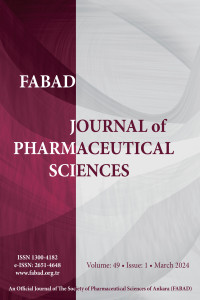Öz
Kaynakça
- Schinella, G. R., Tournier, H. A., Prieto, J. M., Mordujovich De Buschiazzo, P., & Ríos, J. L. (2002). Antioxidant activity of anti-inflammatory plant extracts. Life Sciences, 70(9), 1023–1033. https:// doi.org/10.1016/S0024-3205(01)01482-5
In vitro Evaluation of the Effects of Inula viscosa’s Different Extracts on Wound Healing and Oxidative Stress in Mouse L929 Fibroblast Cell Line
Öz
This study evaluated the effects of extracts prepared using two different methods (decoction extraction and, soxhlet ethyl acetate/hexane extraction) from Inula viscosa on H2O2-induced oxidative stress and wound healing model in mouse L929 fibroblast cells. The cytotoxic effect started to disappear statistically (p<0.05) at concentrations of Soxhlet ethyl acetate/hexane extracts (SoxEHE) in and below 0.1 mg/mL, while the same effect was observed at concentrations of decoction extracts (DE) in and below 0.2 mg/mL. Therefore, 0.2 and 0.02 mg/mL concentrations of DE, and 0.1 and 0.01 mg/mL concentrations of SoxEHEs were used. While cell migration was positively affected in all concentrations of the research, statistically significant results (p<0.05) were obtained from 0.2 mg/mL of DE and 0.1 mg/mL of SoxEHE extracts. Malondialdehyde (MDA) levels were found to be statistically (p <0.05) decreased, but COL1A1 levels were higher in cell lines treated with oxidative stress + extract than in the cell line treated only with H2O2, and reduced glutathione (GSH) levels were higher in cell lines only treated only with extract than in oxidative stress-induced cell lines. Consequently, it has been observed that the extracts have positive effects on migration and oxidative stress. Therefore, I. viscosa may serve as a new therapeutic agent for wound healing.
Anahtar Kelimeler
Medicinal plants extraction scratch assay cell proliferation oxidative status
Etik Beyan
The authors have no personal, financial, or institutional interest in any of the methods, materials, or devices described in this article. The authors declare no conflicts of interest.
Teşekkür
We thank Asst. Prof. Mustafa Kemal Altunoğlu
Kaynakça
- Schinella, G. R., Tournier, H. A., Prieto, J. M., Mordujovich De Buschiazzo, P., & Ríos, J. L. (2002). Antioxidant activity of anti-inflammatory plant extracts. Life Sciences, 70(9), 1023–1033. https:// doi.org/10.1016/S0024-3205(01)01482-5
Ayrıntılar
| Birincil Dil | İngilizce |
|---|---|
| Konular | Farmasotik Botanik |
| Bölüm | Araştırma Makalesi |
| Yazarlar | |
| Yayımlanma Tarihi | 26 Mart 2024 |
| Gönderilme Tarihi | 21 Eylül 2023 |
| Yayımlandığı Sayı | Yıl 2024 Cilt: 49 Sayı: 1 |


